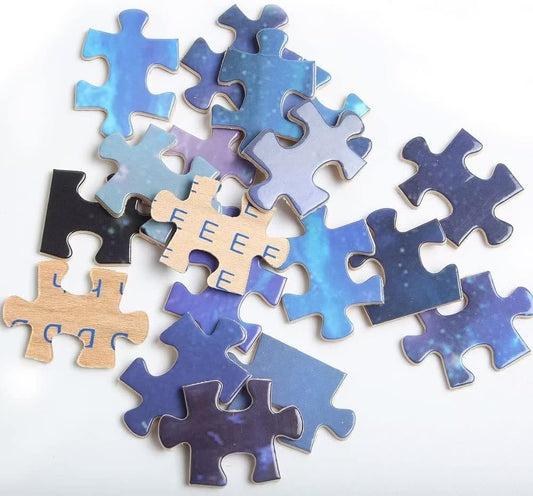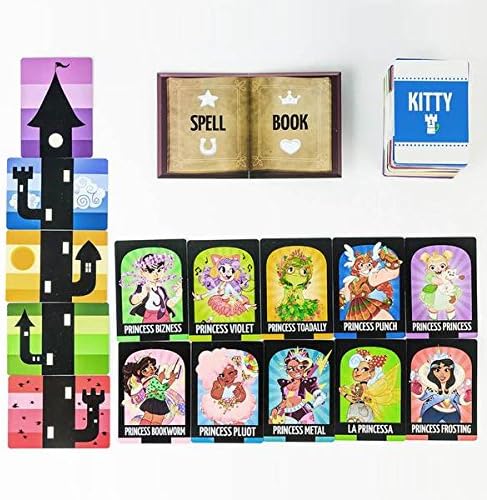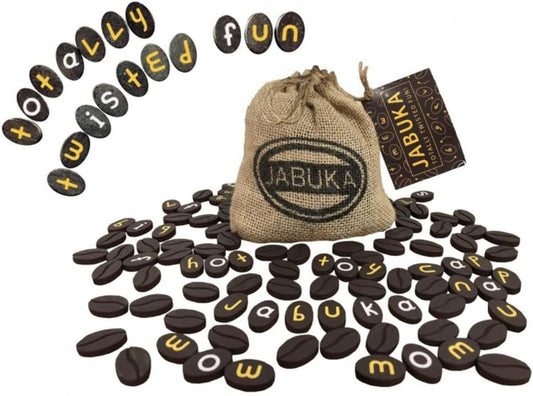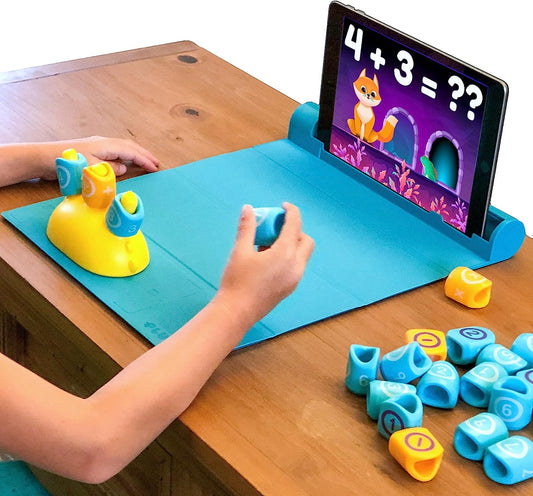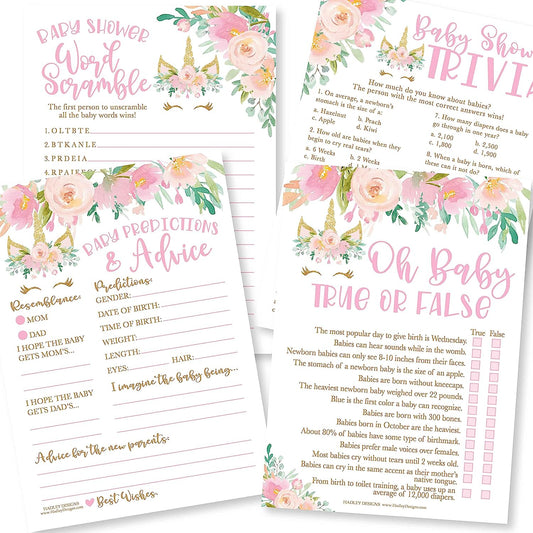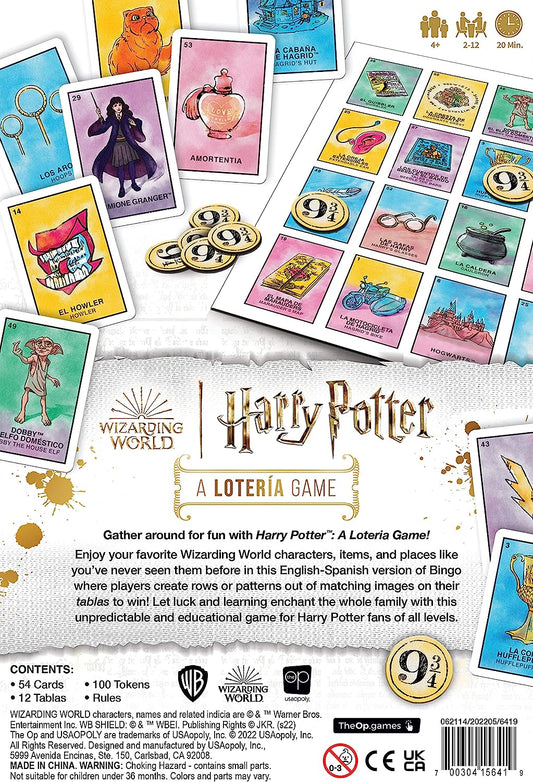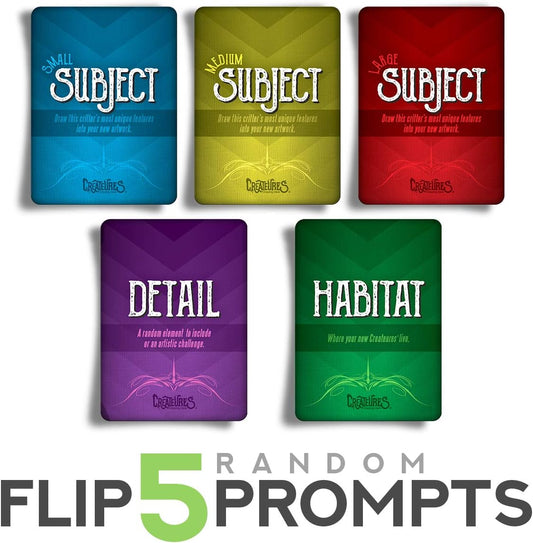-
Puzzles for Adult 500 Piece Jigsaw Puzzle Jesus in His Own Words School Challenge Puzzles Educational Game Wooden Puzzles Props Decompression Toy Difficult Puzzles Kids Puzzles
Regular price $26.26 USDRegular priceUnit price / per$33.87 USDSale price $26.26 USDSale -
Sparkle Kitty Card Game - Entertaining Princess Card Game, Perfect for Family Game Night & Kids Birthday Parties - Fast & Fun, 3-8 Players, Kids 9+
Regular price $24.00 USDRegular priceUnit price / per$30.96 USDSale price $24.00 USDSale -
Play Educational Word Game - Plugo Letters (Kit + App with 9 Learning Games) STEM Toy Gifts for Kids Age 4 5 6 7 8 | Phonics, Spellings & Grammar | 48 Alphabet Tiles (Works with tabs/mobiles)
Regular price $71.99 USDRegular priceUnit price / per$105.82 USDSale price $71.99 USDSale -
Best Word Game Puzzle - Fun Family Games for Kids and Adults, Educational Spelling Party Game, Twistable Letter Travel Set, Portable, Word Games, Spelling Game for 2-8 Players
Regular price $23.98 USDRegular priceUnit price / per$34.05 USDSale price $23.98 USDSale -
Play STEM Toy Math Game - Plugo Count (Kit + App with 5 Interactive Math Games) Educational Toy for 4 5 6 7 8 Year Old Birthday Gifts | Story-Based Learning for Kids (Works with tabs/mobiles)
Regular price $71.99 USDRegular priceUnit price / per$87.11 USDSale price $71.99 USDSale -
Jumanji Deluxe Game, Immersive Electronic Version of The Classic Adventure Movie Board Game, with Lights and Sounds, for Kids & Adults Ages 8 and up
Regular price $29.83 USDRegular priceUnit price / per$43.55 USDSale price $29.83 USDSale -
Light up Musical Bear Airplane Stuffed Animal Rotating Propeller Showing LED 'I Love You' with Cute Removable Bear Pilot Plush Toy Birthday Valentine's Day Gifts for Women Boys Girs, 10''
Regular price $38.39 USDRegular priceUnit price / per$52.21 USDSale price $38.39 USDSale -
50 Unicorn Baby Shower Games For Girls - 4 Games Double Sided, Baby Prediction And Advice Cards, Baby Trivia, True Or False Baby Shower Game, Baby Word Scramble Baby Shower Game To Play
Regular price $29.99 USDRegular priceUnit price / per$38.98 USDSale price $29.99 USDSale -
Loteria | Traditional Loteria Mexicana Game of Chance | Bingo Style Game Featuring Custom Artwork & Illustrations from Films | Inspired by Spanish Words & Mexican Culture
Regular price $23.99 USDRegular priceUnit price / per$30.46 USDSale price $23.99 USDSale -
Mythical Creatures Drawing Game for Kids Mashup Animal Art Ideas. 150 Prompt Cards. Creative Teens + Family Fun Night All Imaginations.
Regular price $23.86 USDRegular priceUnit price / per$28.87 USDSale price $23.86 USDSale -
Learning Resources MathLink Cubes Brain Puzzle Challenge, 80 Pieces, Ages 5+, Linking Cubes, Connecting Cubes, Math Manipulative, Counting Cube
Regular price $23.99 USDRegular priceUnit price / per$34.30 USDSale price $23.99 USDSale
Collection: Magical Word Play
Experience Magical Word Play: Your Ultimate Guide
Step into the enchanting realm of wordplay, where language becomes a canvas for infinite possibilities. Brace yourself as we embark on a journey through magical realms of wit and humor, unveiling the secrets behind the art of puns, riddles, tongue twisters, and alliteration. In this ultimate guide to experiencing wordplay, prepare to be captivated by the power of words.
Imagine entering a world where every sentence is a tapestry woven with clever turns of phrase and sparkling linguistic gems. Here, language takes on a life of its own, captivating minds and hearts alike. As you delve deeper into this realm, you will uncover how brands use wordplay to mesmerize consumers while discovering fun games and activities that sharpen your language skills.
Prepare to explore the nuances of multilingual wordplay as we journey through different languages' unique expressions. From ancient times to the digital age, witness the evolution of wordplay as it adapts and thrives in an ever-changing world.
Get ready to unleash your linguistic prowess as you embrace wordplay in everyday communication. With our expert tips and tricks, you'll wield words like invincible weapons—empowering yourself with unparalleled persuasive abilities.
Are you ready to unlock the magic hidden within words? Join us on this extraordinary adventure—the ultimate guide awaits!
Key Takeaways
- Wordplay is a powerful tool in advertising, helping brands create memorable slogans, hashtags, and jingles that stand out and impact consumer behavior.
- Wordplay is not only entertaining but also beneficial for cognitive development and language skills, making wordplay games and activities valuable for critical thinking.
- Wordplay is a universal form of communication that transcends language and cultural barriers, connecting people through shared experiences and humor.
- Wordplay is prevalent in various forms of media, including literature, songwriting, comedy, and social media, showcasing the creativity and wit of artists and engaging audiences in meaningful ways.
The Art of Puns: Adding Wit and Humor to Your Language
Get ready to unleash a torrent of laughter and wit as you dive into the whimsical world of puns, where language becomes a playground of hilarity and cleverness. The science behind laughter is fascinating, especially when it comes to exploring the neurological response to puns and wordplay.
When we encounter a well-crafted pun, our brains experience a delightful surprise as they navigate through multiple meanings and linguistic nuances. This triggers the release of endorphins, creating an instant sense of joy and amusement.
But the magic of wordplay doesn't stop there. In today's digital age, memes and viral content have become powerful tools for communication. They rely heavily on clever language to engage audiences. Memes often use puns or play with words in captions or images, inviting viewers to join in on the joke and share it with others. This not only strengthens social connections but also spreads humor far and wide.
Now that you understand the power behind puns and wordplay in social media, let's unlock the mystery of riddles: test your brainpower with clever wordplay. By challenging yourself with these brain teasers filled with linguistic twists and turns, you'll exercise your cognitive abilities while having fun along the way.
So get ready to embark on this exciting journey where language becomes an enchanting realm of amusement!
Unlocking the Mystery of Riddles: Test Your Brainpower with Clever Wordplay
Challenge yourself and test your brainpower with clever wordplay as you delve into the mystery of riddles. Solving brain teasers is an excellent way to exercise your problem-solving skills and sharpen your mind.
Riddles are challenging puzzles that require you to think outside the box and find creative solutions. They often involve wordplay, double meanings, and hidden clues, making them both intriguing and frustrating at times.
Exploring riddle origins allows us to trace the history and cultural significance of clever wordplay. Riddles have been a part of human culture for centuries, with evidence dating back to ancient civilizations such as the Egyptians and Greeks. They were used not only for entertainment but also as a means of transmitting wisdom, moral lessons, and cultural knowledge.
By unraveling the secrets behind riddles, you gain insight into different languages, cultures, and ways of thinking. It broadens your perspective and enhances your understanding of language's power in conveying complex ideas through simple yet elusive wordplay.
As we move forward in our exploration of magical word play, let's transition into the next section about tongue twisters: a fun challenge for your phonetics skills.
Tongue Twisters: A Fun Challenge for Your Phonetics Skills
Tongue twisters can be a fun way to test your phonetics skills and improve your pronunciation abilities. Exploring the history of tongue twisters allows us to trace their origins and cultural significance.
Tongue twisters have been around for centuries, with records dating back to ancient civilizations such as the Egyptians and Greeks. They were often used as a form of entertainment or as a tool for teaching language skills.
Practicing tongue twisters offers numerous benefits, including improving pronunciation and speech clarity. By repeating challenging phrases, you can train your mouth muscles to articulate sounds more accurately. This can lead to clearer communication and enhanced confidence when speaking.
Furthermore, tongue twisters can be seen as an exercise in linguistic agility. They require quick thinking, precise articulation, and mastery of complex sound combinations. Regular practice can help develop overall phonetic skills, making it easier to tackle unfamiliar words or accents.
As we explore the power of alliteration in creating memorable and melodic language, we delve into an exciting realm where words come alive through rhythmic repetition.
The Power of Alliteration: Creating Memorable and Melodic Language
Alliteration holds the key to crafting language that's both memorable and melodic. By exploring literary devices like alliteration, you can unlock the power of creating language that resonates with your audience.
The musicality of language is enhanced by repeating consonant sounds at the beginning of words in a phrase or sentence. This repetition not only adds a pleasing rhythm but also helps emphasize certain words or ideas.
Mastering the art of alliteration requires precision and skill. It involves carefully selecting words that share similar sound patterns while maintaining coherence and clarity in your message. When executed effectively, alliteration can create a powerful impact, capturing the attention and imagination of your audience.
Incorporating alliteration into your writing or speech not only elevates its aesthetic appeal but also enhances its persuasive power. Brands understand this concept well and often use alliteration in their advertising campaigns to captivate consumers. From slogans like "Coca-Cola: Open Happiness" to "Nike: Just Do It," companies harness the melodic quality of alliteration to make their brand names and messages more memorable.
As we delve further into wordplay in advertising, we'll explore how brands use various linguistic techniques to engage their target audience on a deeper level.
Wordplay in Advertising: How Brands Use Language to Captivate Consumers
When you see how brands cleverly weave linguistic techniques into their advertisements, it's like stepping into a vibrant painting that brings their messages to life. Wordplay in social media has become a powerful tool for brands to engage online users and capture their attention. By using clever language and witty wordplay, brands are able to stand out in the sea of content and create a lasting impact on consumer behavior.
Here are three ways in which wordplay is used by brands in advertising:
-
Catchy Slogans: Brands often use wordplay to create memorable slogans that resonate with consumers. These slogans play with words, using puns or double meanings to make the message more interesting and engaging.
-
Clever Hashtags: In the age of social media, hashtags have become an important part of brand communication. Brands leverage wordplay by creating catchy hashtags that not only grab attention but also encourage users to participate and share their content.
-
Memorable Jingles: Wordplay is also employed in creating catchy jingles that stick in consumers' minds. Brands use rhymes, alliteration, and other linguistic devices to make their jingles memorable and easy to recall.
As we move forward exploring double entendre - the playful ambiguity of words - we will delve deeper into how this technique adds another layer of intrigue to brand messaging.
Exploring Double Entendre: The Playful Ambiguity of Words
Double entendre is a linguistic technique that adds an intriguing twist to brand messaging, captivating consumers with its playful ambiguity. Unraveling the wit behind double entendre requires understanding the cleverness and subtlety embedded within this form of wordplay.
The art of innuendo lies in exploring the subtle and suggestive side of language, enticing consumers with hidden meanings and multiple interpretations.
In advertising, double entendre allows brands to create memorable and impactful campaigns by engaging consumers on both conscious and subconscious levels. By utilizing words or phrases that have dual meanings, advertisers can craft messages that resonate deeply with their target audience. This technique taps into the power of suggestion, stimulating curiosity and encouraging consumers to unravel the underlying message.
The impact of double entendre is undeniable; it creates a sense of intrigue and anticipation, drawing consumers in and making them feel empowered through their ability to decode hidden messages. Brands that master this technique effectively establish themselves as clever and witty, fostering a strong connection with their audience.
As we transition into exploring poetry and wordplay: the intersection of language and art, we continue our journey into the realm where words become more than mere vessels for communication—they become tools for creative expression.
Poetry and Wordplay: The Intersection of Language and Art
Now that we've explored the playful ambiguity of double entendre, let's delve into the fascinating realm where poetry and wordplay intersect.
Poetry has long been a vehicle for artists to express their thoughts, emotions, and observations through carefully chosen words. But what happens when language itself becomes an integral part of a visual artwork? Enter wordplay in visual art, a captivating fusion of language and artistic expression.
Incorporating text into visual mediums allows artists to convey additional layers of meaning and create thought-provoking juxtapositions. The impact of text on artistic expression can't be overstated; it adds depth, context, and even commentary to the visual elements at play. Whether it's through calligraphy, graffiti, or mixed media installations, the inclusion of words elevates the artwork to new heights.
Beyond its aesthetic appeal lies the science of wordplay—the cognitive processes behind understanding and creating these linguistic gems. How do our brains process puns, anagrams, or acrostics? What mechanisms are at work when we grasp their hidden meanings? Understanding these cognitive processes can shed light on why we find wordplay so delightful.
As we transition into exploring the psychology behind our fascination with wordplay in the next section about 'the psychology of wordplay: why we find it so delightful,' let's unravel the secrets behind this timeless form of linguistic enchantment.
The Psychology of Wordplay: Why We Find It So Delightful
The sheer ecstasy of unraveling the psychological intricacies behind wordplay is a mind-blowing journey that will leave you awestruck. Delving into the psychology of wordplay reveals its profound impact on our cognitive abilities and social interactions.
Firstly, wordplay offers cognitive benefits by enhancing creativity and problem-solving skills. When engaging in wordplay, our brains are challenged to think outside the box, finding new connections between words and ideas. This process stimulates our creative thinking and fosters innovative problem-solving strategies. Additionally, wordplay requires us to mentally manipulate language, improving our linguistic abilities and expanding our vocabulary.
Furthermore, wordplay plays a crucial role in social interactions by building connections and fostering humor. The use of clever puns or witty double entendres creates an instant bond between individuals who appreciate linguistic dexterity. Wordplay can break the ice in conversations, making them more engaging and enjoyable. It also adds an element of surprise and amusement, making us laugh while simultaneously strengthening social bonds.
As we transition into exploring wordplay in literature from Shakespeare to Dr. Seuss, it becomes evident that these psychological aspects are masterfully employed by renowned authors to captivate readers with their clever use of language.
Wordplay in Literature: From Shakespeare to Dr. Seuss
Indulge yourself in the captivating world of literary wordplay, from Shakespeare's intricate plays to Dr. Seuss's whimsical tales. Authors skillfully manipulate language to engage and enchant readers.
In children's literature, wordplay takes on a whole new level of importance. Authors use puns, rhymes, and clever word choices to create a delightful reading experience for young minds. Whether it's the rhythmic cadence of Dr. Seuss or the hidden meanings behind Lewis Carroll's 'Alice in Wonderland,' wordplay adds depth and entertainment to children's stories.
The impact of wordplay on reader engagement cannot be underestimated. It not only entertains but also stimulates cognitive processes such as problem-solving and critical thinking. By challenging readers' understanding of language and encouraging them to make connections between words and their meanings, authors enhance the overall reading experience.
-
Wordplay captures attention: The clever use of language immediately grabs readers' attention and keeps them engaged throughout the story.
-
Wordplay enhances comprehension: By playing with words, authors help readers understand complex concepts in a more accessible way.
-
Wordplay creates memorable experiences: Children often remember books that made them laugh or challenged their thinking through creative word usage.
As we transition into exploring 'wordplay in pop culture: catchy catchphrases and memorable lyrics,' prepare yourself for an exploration of how linguistic playfulness extends beyond literature into everyday life.
Wordplay in Pop Culture: Catchy Catchphrases and Memorable Lyrics
Get ready to have your mind blown with the incredible wordplay found in popular culture, where catchy catchphrases and unforgettable lyrics will have you singing along and smiling from ear to ear.
Wordplay in songwriting is a powerful tool that artists use to enhance their music. Clever wordplay adds depth, humor, and meaning to songs, making them more memorable and engaging for listeners. From double entendres to playful puns, these linguistic tricks keep us on our toes and make us appreciate the artistry behind the lyrics.
In addition to music, wordplay also plays a crucial role in comedy. Comedians skillfully manipulate words to create laughter through puns, one-liners, and clever turns of phrase. This form of humor relies on the audience's ability to quickly recognize and appreciate the playfulness of language.
Wordplay in pop culture not only entertains but also holds cultural significance. It reflects the creativity and wit of artists across different mediums while connecting people through shared experiences of humor and joy. As we delve into the cultural significance of wordplay from a global perspective, prepare yourself for an exploration of how this linguistic phenomenon transcends boundaries and unites us all through its sheer brilliance.
The Cultural Significance of Wordplay: A Global Perspective
Immerse yourself in the cultural significance of wordplay from a global perspective as you explore how this linguistic phenomenon transcends boundaries and unites us all through its sheer brilliance. Can you envision the world coming together through clever wordplay?
Wordplay has long been an integral part of traditional ceremonies across various cultures. Whether it's the use of puns, rhymes, or double entendre, clever language adds a layer of depth and meaning to these rituals. It serves as a way to engage participants and create a sense of shared understanding.
In today's digital age, wordplay has found a new home in social media platforms. Witty wordplay has become a powerful tool for online communication. It captures attention, sparks conversations, and creates connections between individuals across different cultures and languages. From memes to hashtags, cleverly crafted messages have the ability to go viral and spread like wildfire.
As we delve deeper into the realm of wordplay games and activities, let's explore fun ways to sharpen your language skills...
Wordplay Games and Activities: Fun Ways to Sharpen Your Language Skills
Explore the world of wordplay games and activities, and discover fun ways to enhance your language skills while engaging in playful linguistic challenges. Wordplay games and activities offer numerous benefits for cognitive development, making them an enjoyable and effective tool for sharpening your language skills.
Here are some exciting options to consider:
- Crossword puzzles: Solve clues and fill in the grid with words that intersect both horizontally and vertically.
- Anagrams: Rearrange letters to form new words or phrases, providing a mental workout that strengthens vocabulary and problem-solving abilities.
- Tongue twisters: Challenge yourself to articulate difficult phrases quickly and accurately, improving pronunciation and diction.
- Palindromes: Explore words or phrases that read the same forwards and backwards, honing your attention to detail.
Engaging in these wordplay games not only makes learning enjoyable but also cultivates critical thinking skills necessary for success. By actively participating in these activities, you'll develop a deeper understanding of language structures, expand your vocabulary repertoire, refine communication skills, and boost overall cognitive function.
Transitioning into the subsequent section about 'wordplay in different languages: exploring the nuances of multilingual wordplay,' dive deeper into the fascinating world of linguistic play across various cultures.
Wordplay in Different Languages: Exploring the Nuances of Multilingual Wordplay
Discover the fascinating world of linguistic play across various cultures as you delve into the nuances of multilingual wordplay. Cross-cultural wordplay allows us to explore the similarities and differences in wordplay across different languages. It's a mesmerizing experience to witness how different cultures use language creatively, showcasing their unique sense of humor and wit.
Additionally, wordplay in slang unveils hidden meanings and clever wordplay in everyday language. Slang is an ever-evolving aspect of communication that often incorporates puns, double entendres, and other forms of linguistic trickery. Uncovering these hidden gems adds a layer of excitement and intrigue to our understanding of language.
As you venture into this realm, you'll come to appreciate the intricate tapestry woven by words across cultures. The subtle variations in sounds, idioms, and expressions create endless possibilities for playful manipulation. From tongue twisters to riddles, multilingual wordplay invites you on a journey through the intricacies of human expression.
Transitioning seamlessly into the subsequent section about 'the evolution of wordplay: from ancient times to the digital age,' we can observe how this form of linguistic play has evolved over time.
The Evolution of Wordplay: From Ancient Times to the Digital Age
From ancient civilizations to the digital age, wordplay has transformed and adapted, captivating audiences throughout history. The role of wordplay in ancient storytelling was crucial, as it added depth and intrigue to myths, legends, and epic tales. Ancient cultures used puns, riddles, and clever word combinations to engage listeners and create memorable narratives.
As technology advanced, so did wordplay. The impact of technology on modern wordplay can't be overstated. With the rise of social media platforms and the internet, people now have access to a vast array of tools for creating and sharing wordplay. Memes with clever captions, viral hashtags that play with language, and witty tweets all contribute to the evolution of wordplay in the digital age.
The evolution of wordplay is best understood through an unordered bullet list:
- Ancient civilizations used wordplay to enhance storytelling.
- Wordplay has adapted to modern technology.
- Social media platforms provide new avenues for sharing wordplay.
- Memes, hashtags, and tweets are popular forms of modern digital wordplay.
Embracing this rich history and technological advancements allows you to add magic to your everyday communication. By harnessing the power of words through clever linguistic techniques, you can captivate your audience effortlessly.
Incorporate seamless transitions into your subsequent section about 'embracing wordplay in everyday communication: tips and tricks for adding magic to your words' without writing 'step'.
Embracing Wordplay in Everyday Communication: Tips and Tricks for Adding Magic to Your Words
Unlock the hidden potential of your communication by infusing it with the enchanting allure of wordplay, transforming mundane conversations into captivating experiences.
In a world dominated by social media, crafting witty captions and hashtags is an essential skill to master. Wordplay in social media adds a touch of creativity and charm to your posts, making them stand out from the crowd. By cleverly using puns, double entendres, or clever word combinations, you can capture your audience's attention and leave them wanting more.
To incorporate wordplay into everyday communication effectively, it's crucial to have a thorough understanding of language nuances and be well-versed in pop culture references. Stay updated on current trends and familiarize yourself with different linguistic techniques like alliteration, rhyming schemes, and metaphors.
By embracing wordplay in your daily interactions—be it on social media or during comedic performances—you can elevate your communication skills to new heights. So go ahead and immerse yourself in this magical world of words where every conversation becomes an opportunity for enchantment and delight.
Frequently Asked Questions
How can I improve my pun-making skills?
To improve your pun-making skills, focus on mastering techniques for wordplay in comedy writing. This involves understanding the psychology behind the appeal of wordplay, which lies in its cleverness and surprise factor.
Experiment with different types of puns such as homophonic, double entendre, and pun chains.
Practice regularly to develop a sharp wit and playfulness with words. With dedication and persistence, you can become a master of this powerful comedic tool.
What are some popular wordplay games or activities?
To incorporate wordplay into your daily routine, popular games and activities can be a great starting point. One interesting statistic is that 82% of people who engage in wordplay regularly report improved creativity and cognitive skills.
Some popular wordplay games include Scrabble, crossword puzzles, and pun competitions. These activities challenge your language skills, improve vocabulary, and enhance problem-solving abilities.
Additionally, exploring how wordplay differs across languages can broaden your linguistic horizons and provide unique opportunities for creative expression.
How does wordplay differ across different languages?
Cultural influences play a significant role in shaping wordplay across different languages. The unique traditions, beliefs, and values of a culture influence the types of wordplay that are prevalent.
Additionally, language structure also impacts wordplay. Languages with complex grammar or rich vocabularies may offer more opportunities for puns, double entendres, or clever word combinations.
Understanding these cultural influences and language structures is crucial to mastering the art of wordplay in different languages.
Can you provide examples of wordplay in ancient texts?
Unveiling the hidden gems of linguistic wit, ancient texts are a treasure trove of puns and wordplay. Exploring their origins reveals the sophisticated humor of our ancestors.
Take, for example, the works of Aristophanes, a Greek playwright from the 5th century BCE. In his play 'Lysistrata,' he cleverly uses double entendre to create comedic effects. Such instances showcase the timeless appeal and enduring power of wordplay in ancient literature.
What are some practical tips for incorporating wordplay into everyday conversations?
To improve your wordplay skills and incorporate it into everyday conversations, try these practical tips.
First, expand your vocabulary by learning new words and their meanings.
Next, engage in creative wordplay exercises like anagrams or puns to sharpen your wit.
Practice using double entendres or clever word combinations to add intrigue to your speech.
With consistent practice, you'll become a master of linguistic manipulation, commanding attention and power in any conversation.
